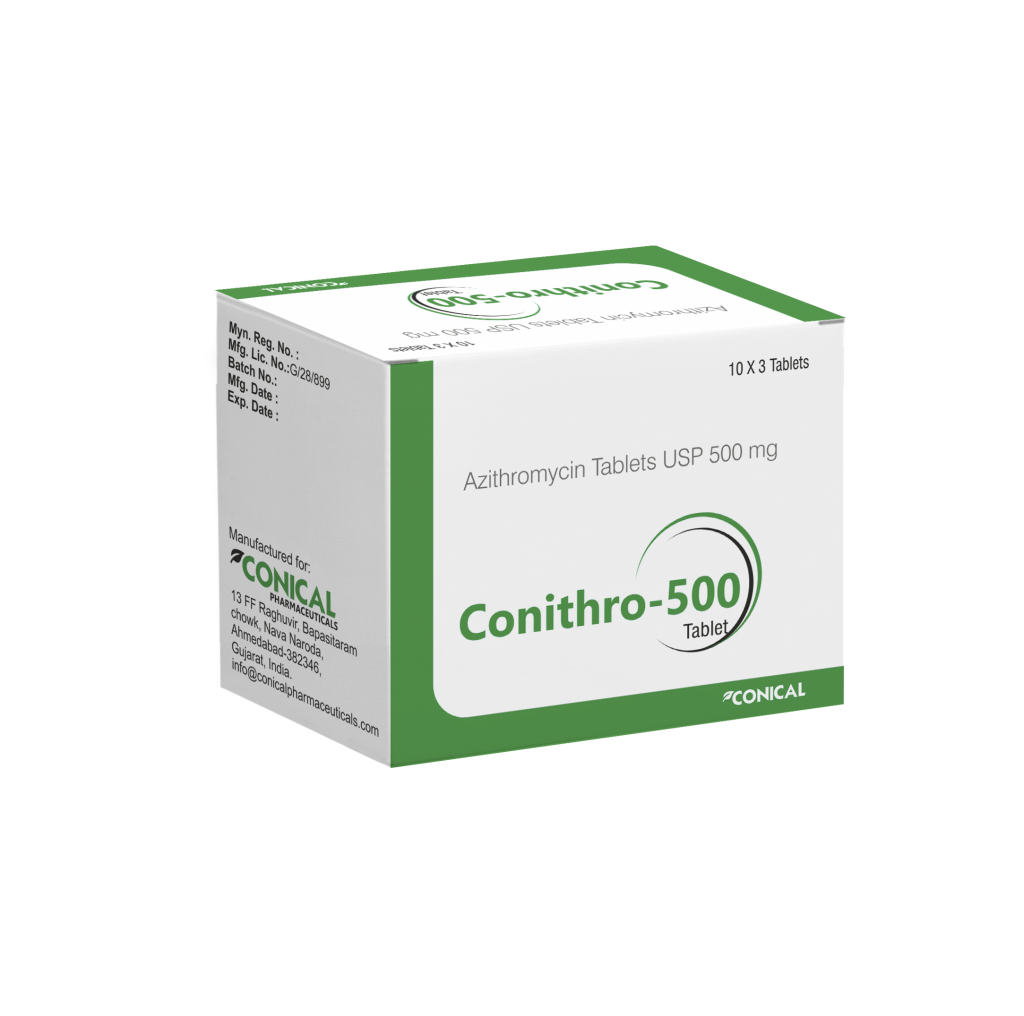
Azithromycin Tablets USP 500 mg can be applied for the treatment of the following infections, when caused by microorganisms sensitive to azithromycin.
− acute bacterial sinusitis (adequately diagnosed)
− acute bacterial otitis media (adequately diagnosed)
− pharyngitis, tonsillitis
− acute exacerbation of chronic bronchitis (adequately diagnosed)
− mild to moderately severe community acquired pneumonia
− skin and soft tissue infections
− uncomplicated Chlamydia trachomatis urethritis and cervicitis
Considerations should be given to official guidance on the appropriate use of antibacterial agents.
Adults: In uncomplicated Chlamydia trachomatis urethritis and cervicitis the dosage is 1000 mg as a single oral dose. For all other indications the dose is 1500 mg, to be administered as 500 mg per day for three consecutive days. As an alternative the same total dose (1500 mg) can also be administered over a period of five days with 500 mg on the first day and 250 mg on the second to the fifth day.
Older people: The same dosage as in adult patients is used for older people. Since older people can be patients with ongoing proarrhythmic conditions a particular caution is recommended due to the risk of developing cardiac arrhythmia and torsades de pointes.
Paediatric population: Azithromycin tablets should only be administered to children weighing more than 45 kg when normal adult dose should be used. For children under 45 kg other pharmaceutical forms of azithromycin, e.g. suspensions, may be used.
In patients with renal impairment: : No dose adjustment is necessary in patients with mild to moderate renal impairment (GFR 10-80 ml/min).
In patients with hepatic impairment:
A dose adjustment is not necessary for patients with mild to moderately impaired liver function.
Azithromycin is well tolerated with a low incidence of side effects.
Blood and Lymphatic System Disorders: Transient episodes of mild neutropenia have occasionally been observed in clinical trials, although a causal relationship to azithromycin has not been established.
Ear and Labyrinth Disorders: Hearing impairment has been reported in some patients receiving azithromycin. In those cases where follow-up information was available the majority of these events were reversible.
Gastrointestinal Disorders: Nausea, vomiting, diarrhea, loose stools, abdominal discomfort (pain/cramps), and flatulence.
Hepatobiliary Disorders: Abnormal liver function.
Skin and Subcutaneous Tissue Disorders: Allergic reactions including rash and angioedema.
General Disorders: The following undesirable effects have been reported in association with DMAC prophylaxis and treatment:
When azithromycin 600 mg is given daily for the treatment of DMAC infection in HIV-infected patients for prolonged periods, the most frequently reported treatment-related side effects are abdominal pain, nausea, vomiting, diarrhea, flatulence, headache, abnormal vision, and hearing impairment.
In post-marketing experience, the following additional undesirable effects have been reported:
Infections and Infestations: Moniliasis and vaginitis.
Blood and Lymphatic System Disorders: Thrombocytopenia.
Immune System Disorders: Anaphylaxis (rarely fatal)
Metabolism and Nutrition Disorders: Anorexia.
Psychiatric Disorders: Aggressive reaction, nervousness, agitation, and anxiety.
Nervous System Disorders: Dizziness, convulsions (as seen with other macrolides), headache, hyperactivity, hypoesthesia, paresthesia, somnolence, and syncope. There have been rare reports of taste/smell perversion and/or loss.
Ear and Labyrinth Disorders: Vertigo.
Cardiac Disorders: Palpitations and arrhythmias including ventricular tachycardia have been reported. There have been rare reports of QT prolongation and torsades de pointes. A causal relationship between azithromycin and these effects has not been established.
Vascular Disorders: Hypotension
Gastrointestinal Disorders: Vomiting/diarrhea, dyspepsia, constipation, pseudomembranous colitis, pancreatitis, and rare reports of tongue discoloration.
Hepatobiliary Disorders: Hepatitis and cholestatic jaundice have been reported, as well as rare cases of hepatic necrosis and hepatic failure, which have rarely resulted in death.
Skin and Subcutaneous Tissue Disorders: Allergic reactions including pruritus, rash, photosensitivity, edema, urticaria. Rarely, serious skin reactions including erythema multiforme, Stevens-Johnson syndrome, and toxic epidermal necrolysis have been reported.
Musculoskeletal and Connective Tissue Disorders: Arthralgia.
Renal and Urinary Disorders: Interstitial nephritis and acute renal failure.
– Rare serious allergic reactions, including angioedema and anaphylaxis (rarely fatal), have been reported. Some of these reactions with azithromycin
have resulted in recurrent symptoms and required a longer period of observation and treatment.
– Since liver is the principal route of elimination for azithromycin, the use of azithromycin should be undertaken with caution in patients with significant
hepatic disease.
– As with any antibiotic preparation, observation for signs of superinfection with non-susceptible organisms, including fungi is recommended.
– Clostridium difficile associated diarrhea (CDAD) has been reported with use of nearly all antibacterial agents, including azithromycin, and may range in
severity from mild diarrhea to fatal colitis. CDAD must be considered in all patients who present with diarrhea following antibiotic use. Careful medical
history is necessary since CDAD has been reported to occur over two months after the administration of antibacterial agents.
– In patients with severe renal impairment (GFR <10 ml/min) a 33% increase in systemic exposure to azithromycin was observed.
Store below 30° C temperature.
Protect from light. Keep the medicine out of reach of children.
Alu-Alu blister packs.
Azithromycin Tablets USP 500 mg is available in an Alu-Alu blister of 10 tablets. Such 10 blisters in a unit carton with package insert.
Contact us directly to receive full information on the product, the formulation, the science behind it, stability data, and more. Our Business Development Manager is a click away.
Conical Pharmaceuticals is a professionally managed and dynamic organization with decades of experience in the pharmaceutical field. With a desire of providing opportunities for a better life, we work very hard to bring quality drugs to our customers. We have instilled a level of trust and confidence amongst our clients by supplying the best quality products.